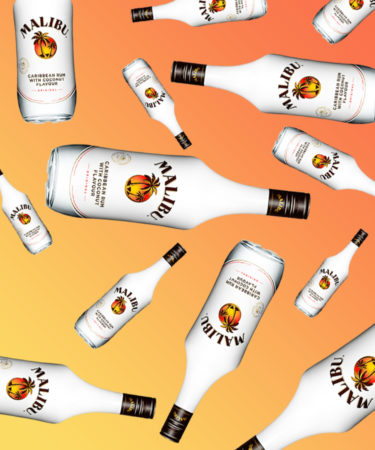Beyond its sweet coconut flavor and vague Caribbean (or was it Californian?) vibe, what most drinkers know about Malibu often begins and ends with how easily the stuff goes down. But there’s more to know about this 1980s-era coconut liqueur (not rum, see below) than its eye-catching bottle and sweet-tasting buzz.
From its multicultural origins to its kinship to Johnnie Walker, here are eight more things to know about Malibu.
Malibu is distilled in Barbados. Probably.
There is some rum in Malibu, and that spirit is distilled in the Caribbean at West Indies Rum Distillery Ltd. Though in truth, tracking down exactly where Malibu is distilled isn’t easy. Pernod says it’s distilled at “the famous West Indies rum distillery” in Barbados, a claim also backed up by the legit-seeming Ministry of Rum (which shares a “Royal Navy Toast of the Day”). But the West Indies distillery itself has a dead website, and Malibu representatives did not respond to requests for clarification.
Malibu has a little bit of English in it.
When you think of Malibu, you probably don’t think of the Royal Crown. (The idea of Colin Firth drinking from a rum-filled coconut is just… wrong.) But it was an Englishman indeed who developed Malibu: Thomas Jago, liquor industry legend who passed away in 2018, was a liquor executive who created both Bailey’s Irish Cream and Malibu, the latter of which was a tremendous effort in rebranding a failing rum called Coco Rico. Jago also went on to develop Johnnie Walker Blue.
(Fun fact, history buffs: If you mix Jago’s marquee innovations — Baileys, Malibu, and Johnny Walker Blue — you’ll have a really, really terrible day.)
Malibu’s rum is molasses-based.
Malibu is distilled from molasses, a sugarcane refinement byproduct. There’s plenty of cool stuff to know about rum production, but key here is knowing that rum can be made from either sugarcane juice or molasses syrup, the latter a byproduct of sugarcane refinement and sugar production. There’s also the harder-to-produce, more agricultural, and delicate “rhum agricole,” comprising an admittedly smaller fraction of the market. As a molasses-based rum, Malibu’s is pretty standard.
How much alcohol is in Malibu?
By law, rum as a spirit has to be bottled at “not less than 80 proof.” The coconut-flavored Malibu Original flagship clocks in at just 21 percent ABV, making it a liqueur, not rum (i.e., do not offer some to a pirate at parlay). Pernod calls it a “flavored rum” where it can legally. So we’ll consider it a rum-aspirational liqueur and call it a day.
There’s a darker side to Malibu.
For those of us looking for slightly higher SPF, er ABV, with our Caribbean sunshine, the good folks at Malibu went ahead and created Malibu Black, a 35-percent-ABV rum-based liqueur (nope, still not straight-up rum). It’s a mix of dark rum and coconut-flavored, rum-based liqueur, proportioned such that the sugar content that caws like a shore bird in Malibu original is hushed here, with most of the flavor coming in as dark, chewy, and hot, like a melted Tootsie Roll that will get you buzzed.
The Northern Hemisphere loves Malibu.
According to Pernod Ricard, the main markets for Malibu are the U.S., the U.K., Germany, France, and Canada. Malibu sold 3.8 million 9-liter cases worldwide as of the end of 2019, and Malibu itself was one of Pernod’s stronger performers in a fiscal year of modest returns (among brands like Jameson, Beefeater, and Havana Club; mix them all together, add some sparkling water or wine, and you’ve got a nice “Modest Returns Spritz”).
It’s a vacation in a bottle — or can.
No shock, Malibu comes in cans. This was inevitable — Malibu is already a flavored, lower-ABV alcoholic beverage, so it was destined to be packaged in portable, affordable aluminum. In February 2020, Malibu Splash, a sparkling ready-to-drink flavored malt beverage, slipped into the beer aisle in skinny 12-ounce cans of bubbly Strawberry, Lime, Passion Fruit and Pineapple flavors. They’ll be available in 4-packs and variety 8-packs nationwide.
More packaging formats include 750-milliliter and 1.75-liter pouches of Blue Hawaiian and Malibu Rum Punch, which are totally not meant to be consumed like Capri Sun. Unless, of course, you’re attending the Malibu Games.
There’s something called the Malibu Games.
The 2020 Summer Olympics are coming up (and you know this already because you’re already getting your “Discover Tomorrow” 2020 Olympics-theme neck tattoo). But in athletic news nobody actually asked for, the Malibu Games are returning for a second year.
The games, which succeeded in year one despite possibly the most cringeworthy promo video you’ll watch this week, will once more bring together a few dozen plugged-in “creators,” a.k.a. (and we didn’t make this up) “young, fun starters,” and challenge them with silly things like slippery races and pineapple-cup relays. Mostly it’s about challenging young people to exploit their fleeting internet-based celebrity for pay and free rum, which, God bless.
FAQs
Is Malibu gluten free?
All of Malibu’s products, including Malibu Original, Malibu Black, Malibu Flavors and Malibu RTDs are considered gluten-free as they do not use any gluten-containing ingredients.
How should you drink Malibu rum?
Malibu rum is best used in cocktails like the Piña Colada, the Mojito, or other rum-based drinks that would taste good with the addition of coconut.
